
Display Contents
Introduction
Location of Finds
Comparisons with the rest of East Kent
Summary
As at
the end of April 2005, a total of 276 Iron Age coin finds (counting
hoards as
one find) have been recorded as having been found on the Isle of
Thanet, some
15% of the total number of Iron Age coins from east Kent, i.e. east of
the
valley of the Great Stour and including Thanet (fig. 1).
Scale: 10mm in 5mm divisions.
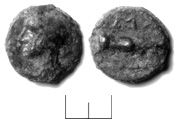
Potin: Kentish Primary Series from
Manston
(Van Arsdell 1406).
(Van Arsdell 1406).

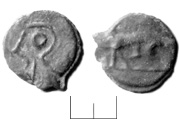
Potin: Flat Linear I Series
from North Foreland
(Van Arsdell 108-3)
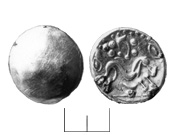
Gaulish Plated Stater,
gold plated with silver core,
Gallo-Belgic E from Ebbsfleet
(Van Arsdell 52-3)
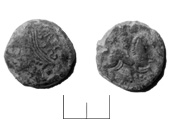
North Gaulish struck
bronze of Nerei Mutinus
from Minster
(Scheers 79)
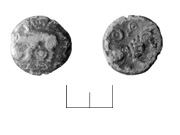
Struck bronze of the
Kentish Uninscribed Series
from Minster
(Van Arsdell 154-5)
Iron
Age coins have been found at approximately 45 different locations on
Thanet,
from single finds to significant concentrations including hoards.
Perhaps the
most important site to produce large numbers of coins is the area
around the
North Foreland, from where around 100 coin finds are now known, many
sadly in
poor condition. A large enclosure of Iron Age date has been known here
for a
number of years and excavations at the St. Stephen's College site ahead
of
redevelopment in 1999 confirmed significant Iron Age occupation in the
immediate area. Among the finds from here was a hoard of 62 Flat Linear
I potin
coins, dating from the first half of the first century BC, found in a
pit
adjacent to an enclosure apparently of similar date. This important
find should
be considered as a potential 'ritual' deposit. Another, disturbed,
hoard(s) has
to be considered as the source for many of the other potin coins found
in the
locality but this cannot be confirmed on current evidence.
Another
Thanet site known for its Iron Age coin finds is at Ebbsfleet, in the
area
adjacent to a Roman masonry building found a number of years ago at
Cottington
Hill. A few of these coins were published as part of the excavation
report in
Archaeologia Cantiana, Vol. CX in 1992, but in excess of forty Iron Age
and
'Mediterranean' coins are now recorded from here. The majority are
again potins
and again many are in poor condition, having suffered from
environmental and
agricultural activity. Other sites of late Iron Age date are hinted at
by coin
concentrations but those sites have seen little or no archaeological
investigation to ascertain the context of these coins and the sites
themselves
shall at present remain confidential.
One recent important find from Thanet is the discovery of a hoard of gold staters of Dubnovellaunos, a Kentish chieftain, believed to have been found at Sarre. Unfortunately, this was dispersed without record and only came to light when a number of these rare coins suddenly appeared in the numismatic trade. This kind of irresponsible action serves no purpose to either archaeology or responsible metal-detecting and is to be greatly regretted.
One recent important find from Thanet is the discovery of a hoard of gold staters of Dubnovellaunos, a Kentish chieftain, believed to have been found at Sarre. Unfortunately, this was dispersed without record and only came to light when a number of these rare coins suddenly appeared in the numismatic trade. This kind of irresponsible action serves no purpose to either archaeology or responsible metal-detecting and is to be greatly regretted.
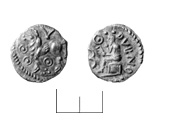
Silver unit of Dubnovellaunos
from Ebbsfleet
(Van Arsdell 453)
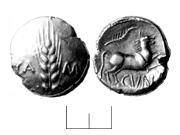
Gold stater of Cunobelin
from St Nicholas at Wade
(Van Arsdell 1931)
Comparing
the Iron Age coin finds from Thanet with those from the rest of east
Kent
reveals a number of interesting features (fig. 2). Firstly, whereas
Kentish
Primary and Flat Linear I potin coins (c.150-50 BC) are only slightly
above the
east Kent mean, Flat Linear II potins (c.50-30 BC), which are very
scarce
across east Kent apart from at Canterbury and Folkestone, are totally
absent
from Thanet.
Perhaps of greater significance is the relative lack of imported coins from Thanet. There are only sixteen gold and nine non-gold Gaulish imports, plus five other ancient coins from the Mediterranean region, from the whole island. Whereas gold imports (which probably had different functions from non-gold coins) from Thanet compare well with the rest of east Kent, non-gold imports compare very poorly, particularly given that non-gold imports in Kent are heavily concentrated in Canterbury and further east; indeed, as a percentage of the total recorded coinage, non-gold imports are less than half as frequently found on Thanet as they are in the rest of east Kent. Even the productive sites on Thanet are notably lacking in imports. It may be the case that the Kentish cross-Channel ports were located on the mainland - the distribution of imports would support this - and Thanet itself had no direct links to the continent.
Perhaps of greater significance is the relative lack of imported coins from Thanet. There are only sixteen gold and nine non-gold Gaulish imports, plus five other ancient coins from the Mediterranean region, from the whole island. Whereas gold imports (which probably had different functions from non-gold coins) from Thanet compare well with the rest of east Kent, non-gold imports compare very poorly, particularly given that non-gold imports in Kent are heavily concentrated in Canterbury and further east; indeed, as a percentage of the total recorded coinage, non-gold imports are less than half as frequently found on Thanet as they are in the rest of east Kent. Even the productive sites on Thanet are notably lacking in imports. It may be the case that the Kentish cross-Channel ports were located on the mainland - the distribution of imports would support this - and Thanet itself had no direct links to the continent.

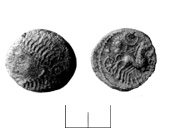
Struck bronze of Eppillus
from Minster
(Van Arsdell 178)
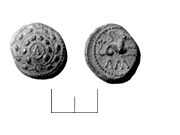
Silver unit of Amminus
from North Foreland
(Van Arsdell 194)
Potins
comprise a very similar proportion of the Iron Age coinage from Thanet
to that
from the rest of east Kent. Struck bronzes are lower on Thanet but
silver
(particularly) and gold are correspondingly higher. Iron Age phase 6
(c.40-25
BC) coins are under-represented on Thanet whereas phases 7 (c.25-1 BC)
and 8.1
(c.AD 1-25) are above the east Kent mean. These differences may be more
apparent than real, being dictated by the areas available for searching
and the
survival level of the coins themselves. There is little difference
between
Thanet and the mainland in phase 8.2 (c.25-40 AD).
Summary
Thanet saw significant coin use from a very early date (c.150-100 BC), indicating that circulation and use was probably similar to that on the mainland. Coin circulation seems to have reduced in the mid to late first century BC, seen in the relative lack of imports and phase 6 coins, before picking up strongly again in phases 7 and 8.1. A number of sites, probably with varying functions, are evident. Thanet can be regarded as part of the general east Kent circulation area, which has been shown to have had a plentiful supply of coinage, and which is a particularly significant region for any study of Iron Age coinage.
Thanet saw significant coin use from a very early date (c.150-100 BC), indicating that circulation and use was probably similar to that on the mainland. Coin circulation seems to have reduced in the mid to late first century BC, seen in the relative lack of imports and phase 6 coins, before picking up strongly again in phases 7 and 8.1. A number of sites, probably with varying functions, are evident. Thanet can be regarded as part of the general east Kent circulation area, which has been shown to have had a plentiful supply of coinage, and which is a particularly significant region for any study of Iron Age coinage.
Version 1. Posted 15.03.07
Version 2. Posted 28.03.07 (References/captions corrected)

All
content © Trust for Thanet Archaeology